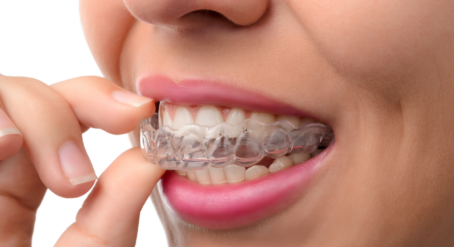Using a combination of brackets and wires, braces work by placing pressure on your teeth until they gradually straighten and align. So it’s normal to experience some initial pain in the teeth, gums and jaw after getting braces.
Just remember, braces only hurt for a short period – and the pain can be managed with over-the-counter medications or simple home remedies. Although majority of patients experience some discomfort during their orthodontic treatment, the end outcome is a stunning smile!
To appreciate why braces can hurt at first, it’s useful to understand the basics of how they work. Simply put, your orthodontist glues a single bracket onto each individual tooth. These brackets connect and support the arch wires – the mechanism that causes your teeth to shift and align. These brackets and wires may irritate the soft tissue of your mouth and lips until they become used to them. Similar to hardened skin on your hands, your mouth also becomes tougher with time, and your braces pain will soon decrease or disappear.

Braces also initially hurt because they are exerting a gentle yet constant pressure on your teeth. Depending on the specifics of your malocclusion, your braces may be pushing, pulling or turning your teeth in place in order to align them. Your teeth are moving through a process of controlled and self-limiting inflammation, therefore your body registers this movement as discomfort initially.
Thankfully, the pain and irritation associated with braces is time-limited – and manageable.
Generally, the first three days after braces are applied produce the greatest discomfort. Your braces are already causing your teeth to shift, and the delicate tissue of your mouth and lips is unaccustomed to the physical rubbing of the brackets and wires. You can expect sore teeth and gums – especially when eating (soft foods such as soup and ice cream are recommended for the first week) – and small sore spots on your tongue and insides of your cheeks are common. This pain and discomfort typically lasts from one to two days, to about a week.
Braces also require adjustment every month or two in order to keep your treatment progressing smoothly. During these periodic appointments, your orthodontist may tighten the bands or springs on your braces so that they exert further pressure on your teeth. You may experience some short-term discomfort in the teeth and gums after these appointments, however, the pain is at its worst in the first few days of having new braces!
In general, it takes around a month for people to get used to the novel sensation of having braces in their mouth. The body is remarkably adaptable; and by the six-month mark, you often don’t notice them much at all.

Fortunately, there are many ways to reduce or alleviate temporary braces pain. Our top 10 pain relief ideas include:
1. Over-the-counter pain medicine
Simple painkillers like paracetamol and ibuprofen are an effective treatment for braces pain. Medically, it is much easier to prevent pain than to treat it once it’s bad, so be sure to take these medicines at the first sign of discomfort.2. Topical anaesthetics
. Rubbing an oral anaesthetic cream on your teeth and gums will help to desensitise them. Ask your pharmacist for their recommendation.3. Dental wax
Non-toxic orthodontic wax protects the soft tissue of your mouth and gums by forming a physical barrier against the irritation of your braces. Re-apply after meals and brushing your teeth.4. Soft foods
Think of it this way: braces change the physical landscape of the inside of your mouth. Soft foods like soup, mashed potato, smoothies and ice cream will help prevent or alleviate pain while your body adjusts. This usually takes about a week. Avoid hard or sticky foods like boiled lollies or chewing gum.5. An ice pack
A simple ice pack will effectively relieve pain and inflammation. Wrap in a clean tea towel and apply it to the outside of your cheeks and mouth.6. Ice water
At a pinch, a glass of cold iced water sipped slowly will help to reduce the discomfort and swelling of braces. Cold foods are also beneficial.7. A warm rinse
Gargling with warm salty water may help heal any cuts or sores inside your mouth.8. A gum massage
Massage is a known pain reliever and can be an effective treatment for sore gums. Simply rub your gums in a circular motion with your finger until the swelling and discomfort subsides.9. Good dental hygiene
It’s important to keep your new braces clean and free from food particles, so regular brushing and flossing are essential. Just remember to brush extra gently to avoid irritating painful teeth and gums.10. Patience and positivity
It mightn’t soundlike a proven pain reliever, but patience and a positive mindset can really help when it comes to dealing with braces pain. Remember, the discomfort of braces only lasts a few days, while your beautiful new smile will be with you for life!Click here to search for an orthodontist near you now.











I would like to know if there are any other ways to ease pain. If there are it would be great! And thank you for the ways to help already.
Hi Bailey,
If you have tried the 10 different ways to ease pain in this article and your braces are still causing you discomfort beyond this, it’s best to book a consult with your orthodontist.
My teeth hurt in sides when I try to bite please tell me why and if this is normal and how to fix it cause none of the ones here help
Hi Javis,
Some discomfort from braces is very normal in the first five to seven days. This can be relieved to some extent by taking Panadol or Nurofen. Also chewing sugarless gum is helpful. If the discomfort persists please reach out to your orthodontist who will offer additonal advice.
Thanks!
is there anything that can be done about bad orthodontistry done in the 90s to a then teen that was that bad the patient has teeth moving behind each other 20 years later? because between a dicey ‘dontist and a…. er…. frugal and passive mother ive had mouth issues for decades which have had ramifications in other parts of my life.
its a question that comes to my mind literally any night im trying to get to sleep, and ive got one tooth being pressed backwards between two others that i cant *not* end up rubbing my tongue raw on that at some stage, is going to come out on its own and you bet i can feel those teeth pressing. nothing caused that other than having two final visits, number one to remove braces and size retainer, the second one a week later to fit the retainer, then go overseas two weeks later, only to get a ‘normal checkup’ on the first day and then a removal and a ‘see ya later’ the second one and being told when asked what about the retainer ‘next appointment’ ‘when?’ ‘thats between me and your mother’ between those two, someone stuffed up, and 20 something years on its damn painful.
Hi there,
While there might not be much that could be done about your original practitioner at this point given so much time has passed, an orthodontist might be able to help you correct any outstanding issues that are causing you pain.
The only way to know for sure is to make an appointment with a specialist orthodontist to get their expert opinion and advice.
You can access our Finder Tool to search for an orthodontist here: https://finder.orthodonticsaustralia.org.au/
We hope this helps!